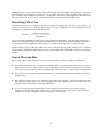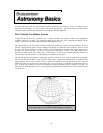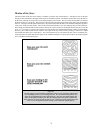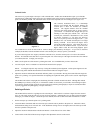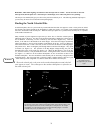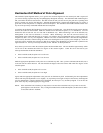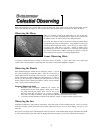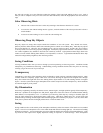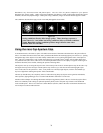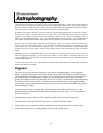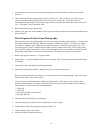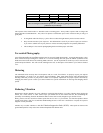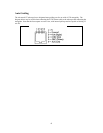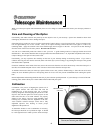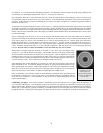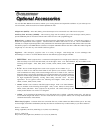
39
disturbances vary from time-to-time and place-to-place. The size of the air parcels compared to your aperture
determines the "seeing" quality. Under good seeing conditions, fine detail is visible on the brighter planets like Jupiter
and Mars, and stars are pinpoint images. Under poor seeing conditions, images are blurred and stars appear as blobs.
The conditions described here apply to both visual and photographic observations.
U
U
s
s
i
i
n
n
g
g
t
t
h
h
e
e
L
L
e
e
n
n
s
s
C
C
a
a
p
p
A
A
p
p
e
e
r
r
t
t
u
u
r
r
e
e
S
S
t
t
o
o
p
p
As mentioned earlier, all refractive optics will exhibit some amount of chromatic aberration due to the prism effect of
lenses. Chromatic aberration will become more pronounced the farther the incoming light rays are off-axis (i.e. passing
through the edge of the objective lens) and virtually unnoticeable on-axis (passing through the center of the objective
lens). This type of aberration is only evident when observing very bright sources of light, such as bright planets and
very luminous stars (like Sirius). There are several techniques that the observer can employ to suppress visible signs of
chromatic aberration, these include; reducing the aperture and using filters.
The objective lens cap covering the objective lens of the telescope has a built-in 112mm aperture stop in the center. By
leaving the lens cap on the telescope with the aperture stop removed, you will allow all the incoming light to pass
closer to the center of the optical axis. Since, most planets are extremely bright objects (visible to the unaided eye)
any loss of light from reducing the aperture will be unnoticeable.
The lens cap should always be completely removed when observing deep-sky objects such as galaxies and nebulae,
where aperture (light gathering power) is essential and chromatic aberration is not an issue.
Another useful technique for reducing aberrations and improving planetary detail is the use of colored eyepiece filters.
Filters are commonly used to bring out particular planetary detail, such as the polar caps on Mars or the bands and
zones around Jupiter. The use of Celestron's Contrast Booster (#94121) reduces the effect of chromatic aberration as
well as improves contrast and resolution.
Figure 6-1
Seeing conditions directly affect image quality. These drawings represent a
point source (i.e., star) under bad seeing conditions (left) to excellent conditions
(
right). Most often, seeing conditions produce images that lie some where
between these two extremes.



